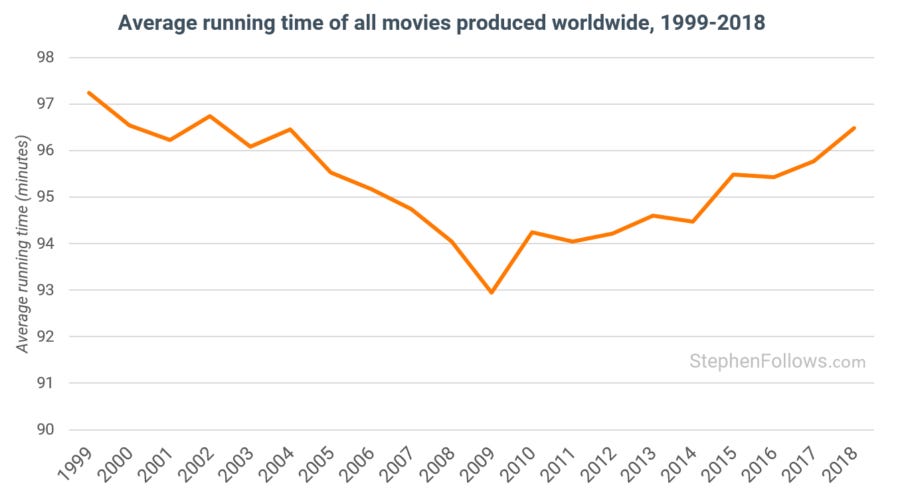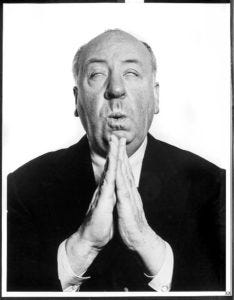Are movies getting longer?

It: Chapter Two is an unusual horror film because it's almost three hours long. This means it is longer than 99.78% of all horror films made over the past twenty years.
Earlier in the year Avengers: Endgame was one minute over the three-hour barrier and Martine Scorsese's up-coming epic The Irishman is expected to be three and a half hours long (longer even than the Godfather: Part Two).
Is this reflecting a wider trend or are these films just a few headline-grabbing examples?
I thought I would investigate.
We'll start will all movies made around the world over the past twenty years, and then zero in on the trends under the surface.
The average running time of all movies produced worldwide
Average running times fell during the 2000s, only to start rising again in the most recent decade. Last year, the average movie lasted 96.5 minutes.

Are top movies longer or shorter than the average movie?
In order to answer this question in more detail, I built four datasets (all looking at 1999 to 2018):
"All movies" - Every single movie made worldwide and listed on online movie listing sites.
"Released movies" - Movies which had a Domestic theatrical release (i.e. in cinemas in America and Canada).
"Top grossing" - The 50 highest-grossing (domestic and theatrical) in the year they were released.
"Oscar-nominated" - Films nominated for the Best Picture award at the Oscars.
I think most people can guess that the Oscar-nominated movies are the longest (an average of 128 minutes over this period).
The top 50 highest-grossing movies of each year are the next longest (average of 114 minutes) followed by all movies released (106 minutes) and the shortest dataset was all movies made (95 minutes).

Part (but not all) of the reason why top-grossing movies have a longer average run time is that there is a great number of extremely long outliers.
The chart below shows the distribution of movies in the "Released movies" and "Top grossing" movies datasets. 10% of top-grossing movies are longer than 140 minutes, compared with just 96% of all movies in cinemas.

How does the genre of a movie affect its running time?
So far we have been lumping all genres together, so let's split them up to see which are the longest and shortest cinema experiences.
Musicals and action movies are the longest, with an average of 107 minutes and 105 minutes respectively. The shortest are documentaries (86 minutes), animation (88 minutes) and horror (90 minutes).

Bonus question: do longer movies cost more to make than short ones?
There's an old producer's joke that when a producer is handed a long script they weigh it in their hand and return it, saying "too expensive".
While this is mostly just a glib line, it does reflect a wider belief in the industry that longer movies cost more to make than short ones. This stands to reason because for each minute of screentime you need to have the script written, sets built, costumes made, cast/crew hired, enough film stock / hard drives, editing time, etc.
But there is a valid argument to say that in many cases, running time is not a significant factor in determining a budget. It all comes down to what you are cutting out when you reduce a script's page count. If you lose whole scenes, then yes, you will have saved money that doesn't need to be spent. However, if you keep the same number of characters and scenes but just reduce lines of dialogue (or speed up the pace of the editing) then you're not going to be saving very much at all. You still need to pay the same actors, the same crew, hire the same locations, etc. You may need a few minutes less music or post-production work (sound and picture) but this is a negligible saving when stacked up against the total cost of producing a movie.
To test this theory, I looked at the Pearson correlation between the budget and runtime of the movies in the "Released movies" dataset (for those where a budget figure is available). The higher the correlation, the greater the connection between budget and runtime. A score of zero means no connection at all and a score of one means completely correlated (i.e. every time one goes up, so does the other).
And indeed it seems that the genres which have the highest spend on location, props and costumes (i.e. Fantasy, Sci-Fi and Westerns) save the most money when cutting their running times. Where those costs are a less significant proportion of the budget, such as documentary, comedy and romance, there is little to no connection.

Notes
Data for today's research came from IMDb, Wikipedia, The Numbers / Opus Data, All Movies, Movie Insider and a number of other sources. The years mentioned are their first public screening or release, other than the Oscar data which relates to the year of the Oscar ceremony.
Epilogue

Hitchcock famously said that the length of a movie "should be directly related to the endurance of the human bladder". This is often quoted but rarely applied, so, in the interests of science, let's see what this reveals.
The average human bladder can comfortably hold around 500 ml (16 ounces) - just over the size of a can of soda. Technically, it can hold more; the current Guinness World Record for the most amount of urine held in a bladder is 22 litres (39 pints) but at that point, it's fair to say this would probably impact your enjoyment of the movie.
In the normal course of events, the average human bladder fills around 60 ml (2 ounces) an hour, meaning that 99.99% of movies pass the Hitchock Test.
However, few people watch movies without at least some form of drink to sip or gulp. It takes about three hours for liquids to make the journey from mouth to bladder but, assuming a normal level of hydration, drinking pushes the existing liquids in your system down within 10 minutes - liquid in, liquid out.
A "small" soda at Regal Cinemas is almost a litre (32 ounces), or twice the size of the comfortable carrying capacity of the average human bladder (the "large" size is 3.4 comfortable bladders). Assuming you don't consume the whole drink during the trailers and adverts, we'll let you drink at a linear rate over the course of the first hour of the movie (I'm aware that in most cases the drinking speed is inversely proportional to how much you have left but there's no need for this maths to get silly).
To summarise: an average person, with a normal level of body hydration who has recently peed, buys a small soda, walks into the cinema and proceeds to steadily drink the soda over the course of an hour. When do they start to feel uncomfortable, and when does their bladder become too full?
They would start to notice their need to pee around half an hour in - barely into the second act of the movie. So a three-hour movie means they would have 38 ounces in a bladder built for 16.
Finally, it's worth noting that the average healthy human bladder can hold 1,600 ml (54 ounces) before being likely to burst, meaning that it's not biologically possible for the vast majority of people to drink a whole "large" soda and watch a movie uninterrupted.
I hope you don't feel that this longer-than-average epilogue is taking the proverbial.


